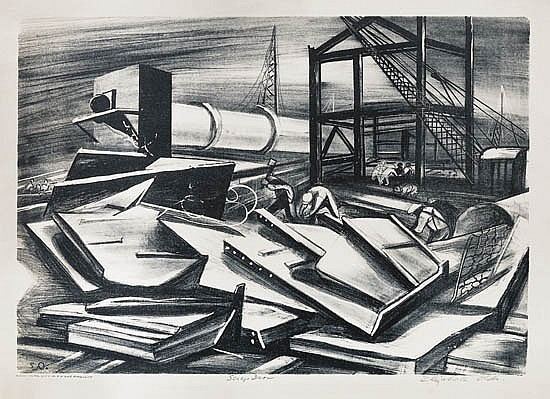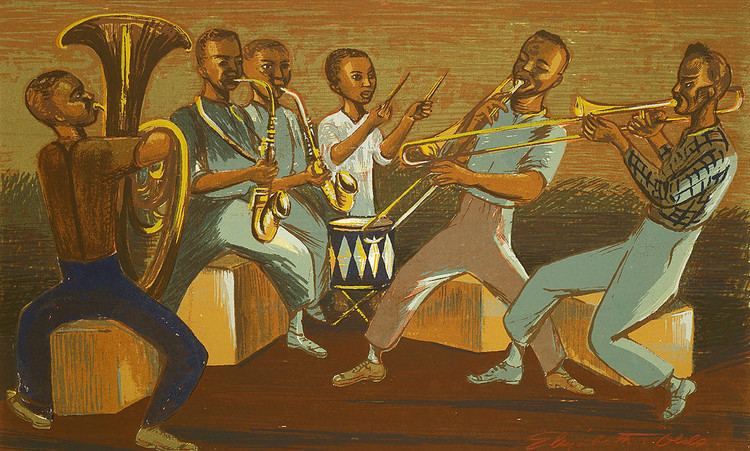Nationality American Role Artist | Name Elizabeth Olds Movement Social Realism | |
 | ||
Born December 10, 1896 ( 1896-12-10 ) Minneapolis, Minnesota, USA Known for Printmaking, Screen printing, Woodcut, Lithography, Illustration, Children's literature | ||
Steel Town, Pennsylvania, c. 1937
Elizabeth Olds (December 10, 1896 – 1991) was an American artist known for her work in developing silkscreen as a fine arts medium. She was a painter and illustrator, but is primarily known as a printmaker, using silkscreen, woodcut, lithography processes. In 1926, she became the first female honored with the Guggenheim Fellowship. She studied under George Luks, was a Social Realist, and worked for the Public Works of Art Project and Federal Art Project during the Great Depression. In her later career, Olds wrote and illustrated six children's books.
Contents
- Steel Town Pennsylvania c 1937
- Early life and education
- Early works
- Great Depression
- Later works
- Childrens books
- Personal life and retirement
- Awards and exhibitions
- References

Early life and education

Olds was born in Minneapolis, Minnesota to a middle-class family. Olds's mother was an art historian, and her mother exposed Olds and her sister, Eleanor, to art through visits to the Walker Art Center and Minneapolis Institute of Arts. Olds's art was first documented in her high school yearbook, featuring a cartoon sketch of a goose at tea. She studied Home Economics and Architectural Drawing at the University of Minnesota from 1916-1918, and received a scholarship to study at the Minneapolis College of Art and Design from 1918-1921. In 1921, Olds received another scholarship to study at the Art Students League of New York where she studied under George Luks.
Early works

The early style of Olds reflects Luks’s influence on her art. The pair experimented with the style and themes of the Ashcan school, visiting the Lower East Side of New York to observe the exotic urban immigrant. During the summers from 1923-1925, Olds was invited to the circles of The Roots and their friends and the Percy Saunders of Clinton, New York. In 1925, with the help of Elihu Root and some bankers, Olds was funded to travel to France. While in France, she observed and sketched the famous circus family, the Fratellini family, and their show, “Cirque d’Hiver.” Olds later joined the troupe as a trick bareback rider. In 1926, Olds became the first woman awarded with the Guggenheim Fellowship, and was granted further travel in Europe.
Great Depression
Olds was fairly sheltered from the Great Depression when she returned to the U.S. in 1929. In 1932, Olds viewed José Clemente Orozco’s nearly finished murals at Dartmouth College, and was inspired by his expressive use of form and political themes. The same year, she moved to Omaha, Nebraska to paint portraits of the family of Samuel Rees, a local industrialist. Olds completed the project, but she became frustrated with the monotony of painting portraits. At the same time Olds was studying the basics of lithography at Rees's printing business.

From 1933-1934, Olds was invited to join the Public Works of Art Project (PWAP) in Omaha. Under the PWAP, Olds created a series of lithographs featuring the bread lines, shelters, and clinics of the Great Depression. Olds’s break from portraiture was fruitful as she developed her style and content, which like Orozco’s murals, used broad, expressive lines and portrayed political themes. Later, Olds studied at a meat packing plant, which inspired her ‘'Stockyard Series’’. "Sheep Skinners," one of the ten black-and-white lithographs, was exhibited in 1935 in the Weyhe Gallery in New York as one of the “Fifty Best Prints of the Year.”
From 1935 until the early 1940s, Olds was a nonrelief employee for the Works Progress Administration-Federal Art Project (WPA-FAP) in the Graphic Arts Division in New York, where she helped younger artists in the silkscreen unit. She also joined the American Artists’ Congress, Artists Union, and other groups with similar interests. Olds became friends with Harry Gottlieb, another nonrelief artist who also focused on industrialism. Together, they observed the mining and steel industries of New York, and their research lead to Olds’s creation of her award-winning print, "Miner Joe." Olds used both silkscreen and lithography for the prints for ‘‘Miner Joe,’’ but it was her lithograph that won first place for the Philadelphia Print Club competition in 1938.
Olds and Gottlieb experimented with silkscreen printing as a fine arts medium. They accomplished this with a few other artists in the silkscreen unit of the Graphic Arts Division of the WPA-FAP in New York. From 1939 until 1941, Olds and Gottlieb opened and ran the independent Silk Screen School for students interested in learning the newest printmaking technologies.
Olds submitted and reproduced 10 prints in The New Masses in 1936 and 1937, a leftist magazine at the time. In the United American Artists under the Public Use of Art Committee, Olds and other artists worked to produce murals along New York subway walls, but the murals were never installed. Olds’s art reflected her leftist political views, but also her social and political awareness at the time. As a WPA-FAP employee, Olds’s prints were intended to go to the government for their purposes, but she selectively sent her leftist prints to George C. Miller, an independent lithographer.
Later works
After the war, Olds redirected her skills and began experimenting with watercolor, collage, and woodblock prints. Her silk screen, "Three Alarm Fire" (1945), prompted Roberta Fansler to suggest that Olds should illustrate children’s books. From 1945-1963, Olds wrote and illustrated six children’s books. In three of her books, Olds wrote about firefighters, trains, and oil, educating her readers about industrialism.
In the early 1950s, Olds was hired as an illustrator-reporter for The New Republic and Fortune (magazine). In the summers of the 1950s and 1960s, Olds was awarded artist-in-residence positions at the artists’ colonies of Yaddo near Saratoga Springs in New York and McDowell in Peterborough, New Hampshire. Her papers are held at the University of Texas.
Children's books
Olds wrote and illustrated six children's picture books. The books published under Houghton Mifflin were created using lithography, and the books published under Scribner’s were created using woodblocks. Feather Mountain, published by Houghton Mifflin in 1951, was a runner-up for the annual American Library Association Caldecott Medal, which recognizes "the most distinguished American picture book for children."
Personal life and retirement
Olds never married. She had close friendships with Harry Gottlieb, Berenice Abbott, and Elizabeth McCausland. In 1972, Olds retired to Sarasota, Florida where she worked until her death in 1991.
